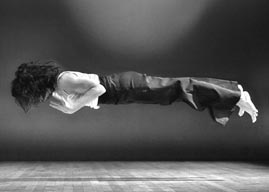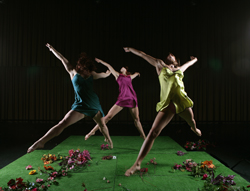Ten years after being birthed by founding artistic director Casimiro Nhussi, Winnipeg’s NAfro Dance Productions has come of age. Western Canada’s only African contemporary dance company celebrated its first decade of dance with the Moving Inspirations Festival (MIF) at the Gas Station Arts Centre. The three-day fête showcased African and contemporary dancers from across Canada in three separate programs that were very much alive and kicking.
Nhussi established the company in 2003 after arriving in Canada from his native Mozambique. And it has grown by leaps and bounds, with most of its productions also showcasing the live nine-piece (including Nhussi) NAfro Band.
As the hosting company, NAfro presented four works during the festival. In Nhussi’s There Is Room for One More Dance, the all-female troupe (Paula Blair, Nicole Coppens, Hélène LeMoullec Mancini, Paige Lewis and Robyn Thomson Kacki) spar with and punch each other with stylized martial-arts kicks. They are interrupted by Nhussi appearing onstage as a kind of deus ex machine bringing a sense of peace and cohesion to the women by teaching them to dance harmoniously with each other.
The more abstract Kipepeo, set to Dobet Gnanhore’s stirring vocal music, features the five dancers twirling like quarks while holding earth-coloured cloths high over their heads suggesting sails or wings of flight. Rip it and Cook It is an example of what NAfro has always done best. Emerging dance artists (Zorya Baskier-Pasternak, Alexandra Garrido, Janelle Hacault, Alexandra Scarola, and Kelsey Todd) burst onstage to perform fluid, hyperkinetic solos in an exuberant display of African-inspired movement. Nhussi also kept things cooking in the festival grand finale, Let Me Dance Before We’re Gone, inviting audience members onstage to perform their own gyrating solos as the band played on.
The festival provided dance fans a rare opportunity to see many leading international African dance artists perform in the city for the first time, on an intimate stage. Over the course of the three days, I became fascinated by the range of disparate styles that make up contemporary African dance – many of which have never been performed in this relatively isolated Prairie city before. In this way, MIF became a notable cultural event. It was also an artistic triumph.
Montreal’s Compagnie Danse Nyata Nyata featured its founding artistic director and renowned pioneer in African dance in this country, Zab Maboungou (who also delivered the opening keynote address), in De/Liberated Gestures. Performed to Marc Keyevuh and Elli Miller-Maboungou’s live African drums, the piece steadily grows in force as Maboungou slices her sculpted arms through space and twists her body across the stage.
Opening night’s sinuous Passage Through the Electric Mist (excerpt), performed by Toronto’s Ballet Creole, delved into the ambiguities of relationships, with Yuhala Muy Garcia and Benton Morris entwining their bodies and throwing themselves at each other with abandon. The athletic duet — choreographed by Gabby Kamino — resonated with all the complexities of love, performed in silence against a sky-blue cyclorama that lent its own timeless quality.
A second Montréal-based company, Muriva Dance, presented Nyau, a work inspired by a South African coming-of-age ritual where young boys and girls shed their fears to embark on the journey of adulthood. It was choreographed and performed by Gibson Muriva with Katia Lacelle, with the two appearing in body paint and tribal grass skirts. The dance alternates between rhythmically driven solos and more fluid duets where the dancers shrug their shoulders, swivel their hips, lift and capture each other in midair as they fall to the ground.
Cross Currents was presented by Toronto’s COBA (Collection of Black Artists). It is a kaleidoscopic showpiece of percussive movement featuring company members Dammecia Hall, Nickeshia Garrick and Mikhail Morris. At times the three seem to morph together as one, an interconnected organism. Set to a recorded score by the Trevor Watts Drum Orchestra, this hypnotic work also includes costumes by its choreographer BaKari I Lindsay.
Calgary choreographer Michèle Moss’s Right Down to her Baby Finger offered a jazzy solo with plenty of streetwise attitude in which every one of dancer Tara Wilson’s limbs seemed in constant motion. With Wilson garbed in funky sneakers, pants and vest, the piece included moonwalking and an array of body isolations.
KasheDance’s Ke-Ashe (interludes within) was performed by Artistic Director Kevin A. Ormsby. In it, Ormsby sheds his pedestrian shirt and trousers like a snake’s skin to expose his inner humanity. As Ormsby gradually strips down to reveals his stark nudity, his movements become more fluid and free, challenging any preconceived ideas of what dance is, or can communicate.
Soul (excerpts) by New York City’s Sean McLeod Dance Experience, presented three dramatically compelling sections from McLeod’s longer, five-movement work that explores an African mythology of how the world began. This relatively brief taste made me immediately wish to see the piece in its entirety. In the first excerpt, Origin of Soul, McLeod appears in flowing red robes and black bodysuit, vocalizing with guttural cries, spoken text and song. Next, Soul of Women, a trio performed by Tamika Del a Rosa, Devon McLeod and Andrea Mariani, is more balletic in nature: it was particularly effective when the dancers became silhouetted against a burning orange backdrop. The piece bleeds into a final duet, Strength of Women, in which the two remaining dancers perform (mostly) in unison, mirroring each other’s gestural movements with a sense of dignity.
The programming at MIF showcased much more than the rich bounty of African dance with a strong collection of local Winnipeg ballet, flamenco and modern dance artists also adding to the synergistic melting pot. Theatre Flamenco Artistic Director Claire Marchand nearly stole the show with the solo Soleo, her dancing integrating seamlessly with flamenco guitarist Jim Shewchuck. Two watchful palmistas in straight-backed chairs create an intimate, late-night cantina feel with the sudden crack of Marchand’s heel on the floor breaking the slow-burning tension.
Drive Dance’s Kathleen Hiley was also riveting in Stephanie Ballard’s Lithium for Medea, choreographed in 1984 for the great Margie Gillis. Young Lungs Dance Exchange presented the visually arresting Puncturing the Clouds, Part 2 in which bewigged soloist Tanja Woloshen stood in a pool of light with mouth agape and hands gnarled into fists
Winnipeg’s two major dance-training programs were also well represented by students of the Royal Winnipeg Ballet School’s Aspirants Program, Katie Bonnell and Jera Wolfe, who performed in Gabriela Rehak’s A Beautiful Lie, and Gaile Petursson-Hiley’s In Scarlet, performed by six students (Carol-Ann Bohrn, Hannah Everest, Ekaterina Likhotin, Courtney Penner, Amy Webb and Ardley Zozobrado) from The School of Contemporary Dancers.
Winnipeg’s Contemporary Dancers, comprised of Kayla Henry, Lise McMillan, Johanna Riley, Ali Robson, Sarah Roche and Mark Medrano, performed Odetta’s Songs and Dances choreographed by its late founding artistic director Rachel Browne. Created in 1964, the folksy ensemble work features the haunting vocals of African-American civil rights activist Odetta. (The work will also be staged during WCD’s three-city tribute tour of Browne’s works in January 2013.)
Gearshifting Performance Works artistic director/choreographer Jolene Bailie’s Excerpts from New Work in Progress (danced by Branwyn Bundon, Jillian Groening, Nina Patel and Krista Nicholson) was set to John Cage’s iconic prepared piano music. The rhythmically percussive score – evoking imaginary, modernistic thumb pianos – punctuated the quartet’s fluid, interconnected movement in which dancers took turns lifting and carrying each other, or breaking from the ensemble in their own fleeting solos.
Generally speaking, NAfro: Moving Inspirations Festival achieved what it had set out to do: celebrate its ten-year anniversary in a city renowned nationwide for its strong legacy of professional dance artists. However, by showcasing virtually every dance company in town during three wildly eclectic programs, the company’s artistic focus inadvertently became diffused. By the end, I wasn’t certain if the festival intended to celebrate NAfro’s roots in the community or Canadian dance in general.
However, as the city’s first major dance festival in decades – the last being the Festival of Canadian Modern Dance series held during the mid-1980s – local dance aficionados were more than ready for a celebratory gathering that also included daily public choreographic workshops and demonstrations. If Canadian culture truly aims for that mythical mosaic, then MIF more than succeeded by bringing together internationally acclaimed dance artists and groundbreaking pioneers in contemporary African dance to share the local stage. NAfro’s first major festival not only moved those who came to this unique event, but likely has inspired a new generations of dancers.
Tagged: African, Contemporary, Festival, Performance, MB , Winnipeg




